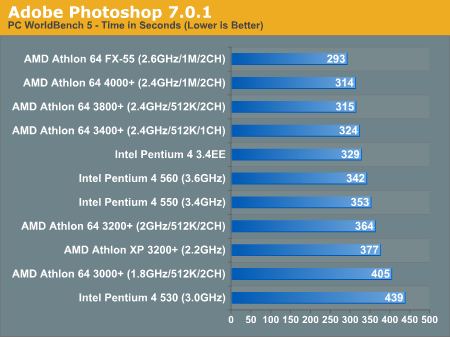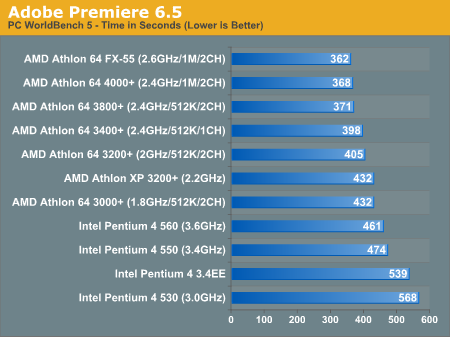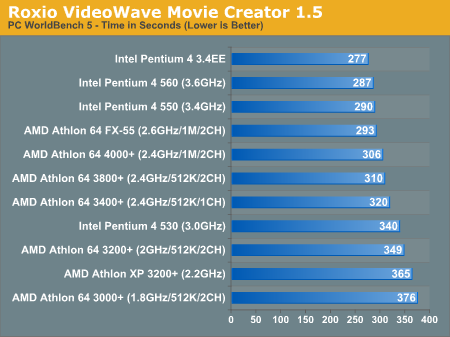AMD Athlon 64 4000+ & FX-55: A Thorough Investigation
by Anand Lal Shimpi on October 19, 2004 1:04 AM EST- Posted in
- CPUs
Video Creation/Photo Editing
Adobe Photoshop 7.0.1
With the later releases of the Athlon XP, AMD began to offer fairly solid performance in Photoshop but with the Athlon 64 AMD managed to seal their fate - making AMD the platform of choice for Photoshop users.
The Top four spots in WorldBench's Photoshop 7 test are won by AMD, first by the 2.6GHz FX-55 and then by the three chips at 2.4GHz. As we've seen in the past, image editing doesn't benefit all that much from high bandwidth memory subsystems, so there's little benefit from a larger cache (0.3%) or from a dual channel memory setup (2.7%).
Despite its higher clock speed, the Pentium 4 560 takes a back seat to the Extreme Edition, justifying the EE's continued presence for a little while longer. Though with plans for a Pentium 4 4GHz scrapped, it seems like we'll be seeing a lot more of the Extreme Edition.
Athlon XP owners will find little reason to upgrade to an entry-level Athlon 64 for Photoshop use, as the two 3200+s manage to perform very similarly despite architecture and clock speed differences.

Adobe Premier 6.5
Prescott seems to do quite a bit for Intel here, with the 560 and 550 easily offering better performance than the 3.4EE, despite smaller caches. That being said, even the top of the line Pentium 4 560 can't outperform even the Athlon XP 3200+ in this test. While WorldBench does use an older version of Premier, it is one that is still widely used, making these results quite pertinent.
Once again we see very little need for the larger cache of the Athlon 64 4000+, but more of a tangible benefit from the move to Socket-939 from Socket-754 (6.7%).
AMD simply dominates this test; Premier users should know what platform is right for their needs.

Roxio VideoWave Movie Creator 1.5
While Premier is a wonderful professional application, consumers will prefer something a little easier to use. Enter: Roxio's VideoWave Movie Creator, a fairly full featured yet consumer level video editing package.
Intel has worked very closely with Roxio in the past, thus it's no surprise to see Movie Creator take advantage of the Prescott core as best as possible. The Extreme Edition still takes the crown, but the 560 and 550 manage to keep AMD's best at bay.
The Athlon 64 FX-55 is still within striking distance of the 3.4EE at only a 5% deficit, but the gap grows as we look at cheaper AMD solutions. Intel wins here with AMD in a close second.











89 Comments
View All Comments
HardwareD00d - Tuesday, October 19, 2004 - link
Fantastic article, obviously very well thought out.I would have liked to see a comparison between the 4000+ and the "real" FX-53 to really back up your rebadging theory (yeah I know speed+cache+memory width are equal between the two, but just to make sure AMD isn't pulling some magic out of there butt somewhere else).
Marsumane - Tuesday, October 19, 2004 - link
Yes, thanks for the XP comparison. I find it interesting how its not performing as well as it used to in games. (doom 3, farcry, cs:s)Also, your ut2k4 benches seem off. How is doom 3 pulling 50% more frames at the same res? Maybe your ut is at 16x12? I pull similar frames on ut w/ my 9800p oced.
ksherman - Tuesday, October 19, 2004 - link
I like the ending... It sounds mysterious!alexruiz - Tuesday, October 19, 2004 - link
I will suggest again to include some Ulead Video Studio 8.0 benchmarks for video encoding. Ulead is by far the fastest consumer grade video editor / renderer, it is the most complete and one of the most popular. In fact, it is almost 50% faster than Pinnacle 9, and almost 100% faster than videowave.Roxio has really been working with Intel as all previous version of video wave ran better on AMD hardware. As reference, results video wave 6 or 7 would be interesting. Newer doesn't always mean better, as you can see from Adobe Premiere. Version 7.0 is quite slower than 6.5 doing the exact same thing in the same platform.
For DivX encoding, a run with virtualdub/virtualdubmod or DVD2AVI would be nice, as they are very fast and extensively used.
Just some comments
Alex
Araemo - Tuesday, October 19, 2004 - link
Thank you thank you thank you for including an Athlon XP.This allows me to better judge where my current Barton 2.4 Ghz sits. ;P So I know when an upgrade to the next cheap overclocker will give a good enough performance boost to be worth the money.
stephenbrooks - Tuesday, October 19, 2004 - link
Here's an idea to play with: how about some 2D scatter plots of Performance/£ and Performance/Watt? Obviously not on everything - that would clutter it - but perhaps on one or two key things it'd be nice to see.Zar0n - Tuesday, October 19, 2004 - link
EDIT #22 There is no 3400+ for SK 939 only 3500+Zar0n - Tuesday, October 19, 2004 - link
Nice article BUT:You should make C&C power consumption and temperature
Also some OC tests.
The Battle for Value is not correct:
1º WHAT about price of DDR1 VS DDR2?!
2º MB for INTEL are more expensive, ~40€ is a great difference in a MB price.
3º 0.09 AMD are just introduced so they are going to come down, not much but they are.
In order to be fair you should compare with AMD 3400+
AMD as a clear winner here.
mczak - Tuesday, October 19, 2004 - link
power consumption at idle - is this with or without cool 'n' quiet (I suspect without)?Uff - Tuesday, October 19, 2004 - link
I have to agree with #18 - it's not worth paying more than twice the price of a 3400+ just to get 3800+ on 939 platform.Many say 'OH! But s939 is more upgradable!', but if you think about it, by the time you upgrade next there are very likely going to be new motherboards available aswell and you end up upgrading that anyway. Not to mention motherboards cost virtually nothing compared to cpus.